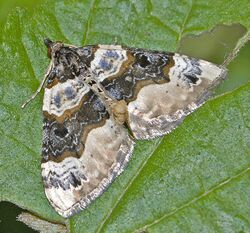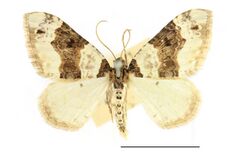Biology:Cosmorhoe ocellata
| Purple bar | |
|---|---|

| |
| Cosmorhoe ocellata | |
| Scientific classification | |
| Kingdom: | |
| Phylum: | |
| Subphylum: | |
| Class: | |
| Order: | |
| Family: | |
| Tribe: | |
| Genus: | |
| Species: | C. ocellata
|
| Binomial name | |
| Cosmorhoe ocellata (Linnaeus, 1758)
| |
| Synonyms | |
| |
Cosmorhoe ocellata, the purple bar, is a moth of the family Geometridae.[1]
Distribution
The species can be found in the Palearctic ecozone, which includes Western and Central Europe including the British Isles, Central Asia, Asia minor and Kyrgyzstan.[2]
Habitat
In the Alps, it can be found at altitudes up to 1500 meters.The species is found in many different habitats, including heathland, deciduous and mixed forests, forest clearings, bushy places, grasslands, fens, scrub, gardens and park-like landscapes.[3]
Description
Their wingspan is between 20–29 mm and the length of their forewings is between 13–15 mm.[3] The ground colour of the forewings is creamy white to bright white. The base and midfield are colored black to blue-black. The latter is crossed by two bright lines. In the midfield band is a deep, jagged spot. In the bright areas between the basal area and the midfield as well as in the marginal field are grey or black spots of varying degrees. The hindwings are whitish and show a small black middle spot.[4]
Caterpillars are brownish, with bright angled markings on their backs and bright stripes on the sides. Pupa is usually shiny red-brown.[5][6]
Biology
This species shows two generations in the southern United Kingdom (from May to early July and from August to mid-October),[3] but a single brood further north. The moths fly from May to August in British Isles, from mid April till October in other parts of the range.[7] They are active from dusk onwards.[7] The larvae feed from June to September on various species of bedstraw (mainly Galium mollugo and Galium verum). The larvae hibernates as a full-grown larva, They pupate in a cocoon.
References
External links
- Paolo Mazzei, Daniel Morel, Raniero Panfili Moths and Butterflies of Europe and North Africa
- Vlindernet.nl (in Dutch)
Wikidata ☰ Q1306112 entry


